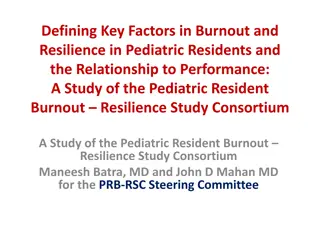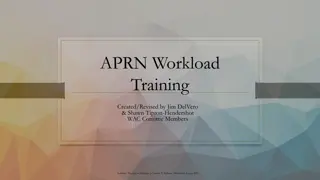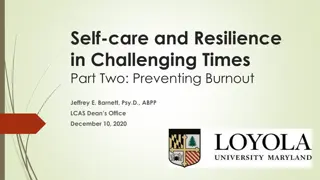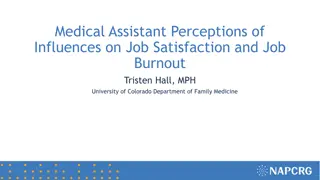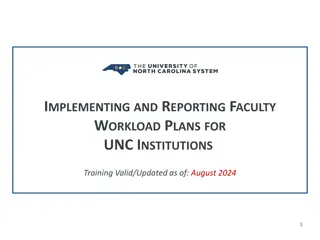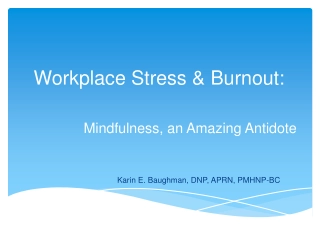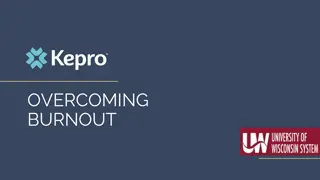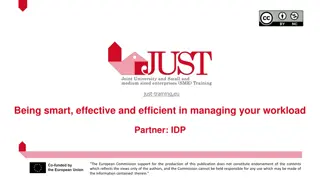Design for Better Workload: Analyzing Burnout and Finding Solutions
This guide focuses on analyzing burnout root causes, identifying potential solutions, and leveraging team resources for better workload balance. It provides methods to address work overload, fatigue, resource allocation issues, and emphasizes team collaboration and knowledge sharing for effective recovery and work plan implementation.
Download Presentation

Please find below an Image/Link to download the presentation.
The content on the website is provided AS IS for your information and personal use only. It may not be sold, licensed, or shared on other websites without obtaining consent from the author. Download presentation by click this link. If you encounter any issues during the download, it is possible that the publisher has removed the file from their server.
E N D
Presentation Transcript
Design for better workload
Background This guide includes practices and tips to better balance workload and business needs, by: Analyzing Burnout Root Cause Analysis Identifying Potential Causes of Burnout Learning tools to handle workload balance Using suggested outline for team discussion
Burnout Root Cause Analysis and Solutions Discuss with the employee: Who is the employee? Which region, manager, account? I noticed that you worked during the last 3 weekends it is important for me to understand the reasons Identify the burned-out employee Weekend work Weekly hours Vacation Sick days Fatigue Why is it happening? What are the causes, in your view? If we wanted to change that what should we do? Which burnout area? Discuss with the employee if needed: What is the work overload environment? Personal issues? Project status SLAs Taking care of relatives Health condition/worries Customer demands Number of resources How can we make sure you recharge? How can I help you take small steps to recovery? Workload distribution in the team Go-to person Unique knowledge and lack of back up Work inefficiencies Lack of boundaries between personal and work time Stress Discuss with the employee: Potential causes
Potential Causes Fatigue Taking care of relatives/ worries The The The employee is the most experienced employee is center of knowledge employee is always available Not enough resources Causes Manager s awareness and behavioral change Prioritization Guidance process improvement Knowledge sharing and training Ways for Recovery Team s Skills development Solutions Work Plan and Recovery 4
Leverage the power of the team (1/3) Now that you understand the root cause on the one hand and people s needs on the other, this could be an opportunity to use the team s power for a plan. The employee is the most experienced The employee is center of knowledge Team s skill development/knowledge sharing: Examine a skills matrix of your team and look for ways to decrease dependency on one experienced employee. Knowledge sharing and training Team s Skills development Identify candidates and set a learning program for them. Define a knowledge sharing program and enforce routing of tasks to newly trained team members. Invest time in planning pairs/trios for smooth handovers of tasks. 5
Leverage the power of the team (2/3) Manager awareness and behavioral change: The Be aware and create a weekly planning while ensuring a realistic and fair workload. Review team workplans and redistribute individual assignments and vacation time accordingly. employee is always available Maximize the team potential the best way possible, consider their strengths, skills, and development areas, and allocate the right tasks to the right people. Manager s awareness and behavioral change 6
Leverage the power of the team (3/3) Empower your team and encourage creativity for process improvement: Consult with them on planning & timelines, potential obstacles, risks and mitigations to get assignments completed on time. Invite people to share different PoVs on what can improve work and save time for the whole team, encourage them to brainstorm and come up with innovative ideas. You can use the Pareto Principle (AKA 20/80 rule). This principle implies that 80% of our output comes from 20% of our efforts. It can help you explore where you need to devote efforts so as to increase productivity and performance. Explore where your 20% lies - and become more productive, or explore where your 80% lies, and improve these cases. Not enough resources Prioritization Guidance process improvement Aligned Rescope and re-prioritize tasks with your manager based on your unit s objectives. Whenever possible, reevaluate initiatives that are not urgent or meet immediate needs. Postpone or Pareto/ Identify bottlenecks Your focus Not Aligned Push for new owners Remove 7
Leverage the power of the team Suggested outline for team discussion (1 hour) Step Points for discussion Examples Opening and context (5 min) Explain the purpose of the discussion and the rationale. Discussion objectives: Show the team s 20/80 Pareto, implications for the teamwork in the next few months, and your view on what needs to be changed. Share Burnout slide and identification. The implications for our team (10 min) Proactively re-planning & maximizing Ask - What are our challenges in your view? Share rescope and re-prioritize and Pareto analysis. Ask for their PoV. What do they consider the 80%? 20%? What can we learn from our data? How do they see the match between the task and the people? The backups? What should be changed? Challenges and potential solution - time to empower your team and encourage creativity (40 min) Summary and closure (5 min) Encourage team members to share their thoughts on challenges. Together Identify bottlenecks, look into Pareto of team deliverables. Apply creative thinking to identify solutions. Use priority matrix (prepare in advance and align with your manager) What are most repetitive tasks in the next 3 months that we should handle differently / worth investing in automating? If we do a process mapping, where are things stuck in loops? Where do we see duplications with other teams? What are the most important and beneficial assignments to work on? Estimate time investment and resources Consider RCA, elimination, additions, different sequencing, working differently with interfaces, automation and other variations of work to get the results with less time and energy. Share main takeaways of planning and agreements on shifting work and tasks. Thank you for sharing and contributing. Please remember I am here for you, for any need, personal or work related. Thank the team for specific ideas that have contributed. Willingness to commit should be high to ideas raised by the team itself. Thank those who show positive attitude and can do approach and wish the team good luck in implementing the chosen path. Share implementation timeline, when and how you ll revisit the plan. 8


